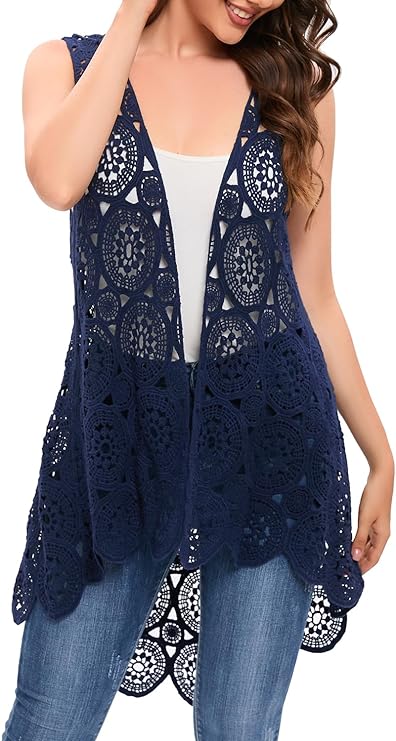Estimated reading time: 17 minutes
Introduction
In today’s fashion landscape, kimonos have transcended their traditional roots to become a major player, showcasing their ability to style a kimono in ways that resonate with modern sensibilities. Are kimonos in style? Absolutely. They have been masterfully integrated into contemporary fashion, demonstrating versatility and cultural richness. The floral print kimonos paired with sandal or heel combinations are particularly popular, blending traditional elegance with modern boho vibes. This reflects not only a global appreciation for their aesthetic but also their adaptability in various style contexts, from casual tee and legging outfits to more formal ensembles.
Kimonos have evolved to accommodate a variety of modern wardrobe staples, including oversized shirts and even swimsuits, illustrating their wide-ranging appeal. Designers continue to explore new realms with kimonos, incorporating elements like wear kimonos with different textures and accessories to create unique, eye-catching looks. Whether it’s the soft drape over a swimsuit at a beach party or a structured kimono over leggings for a city outing, the kimono remains a symbol of timeless fashion. As we continue to see these traditional garments influence mainstream trends, it’s clear that kimonos are not just in style—they are defining it.
Key Takeaways
- Kimono-Inspired Fashion: Modern fashion trends increasingly incorporate kimonos, blending traditional Japanese aesthetics with contemporary style.
- Cultural Fusion in Design: Designers creatively merge kimono elements with Western fashion, creating unique, culturally diverse garments.
- Sustainability and Kimonos: Using kimonos in current fashion highlights a growing trend toward sustainable and timeless pieces in the industry.
- Global Popularity: Kimonos have gained global popularity, signifying a shift towards more inclusive and diverse fashion choices.
- Innovative Fabric Use: Contemporary fashion is experimenting with innovative fabrics in kimono designs, pushing the boundaries of traditional garment making.
The Timeless Appeal of Kimono Fashion
In summer 2023, the timeless appeal of kimono fashion continues to captivate. Whether you choose to wear a kimono in a traditional style or opt for a modern kimono, these garments adapt beautifully to various settings. Kimono looks have diversified, showing that they are still in style. For a casual look, pair your kimono with denim shorts; this combination enhances the vibe of your outfit, blending classic and contemporary elements seamlessly. Kimonos are a great way to express personal style, especially when exploring ways to wear a kimono with skinny jeans or as part of a chic kimono outfit. For those considering how to integrate kimonos into their wardrobe this year, short kimono designs are trendy, demonstrating how the kimono can be worn with versatility.
Reasons Why Kimonos Remain Popular
- Versatility in Design: Kimonos offers a unique blend of simplicity and sophistication, making them adaptable to various fashion trends and personal styles.
- Cultural Significance: The kimono is deeply rooted in Japanese culture, representing a rich history that resonates with people worldwide.
- Aesthetic Appeal: With their distinctive silhouette and intricate patterns, kimonos provide a classic and modern aesthetic.
- Inclusivity in Fashion: The kimono’s unstructured form suits all body types, promoting a more inclusive approach to fashion.
- Sustainability Factor: As a symbol of enduring fashion, kimonos encourage sustainable practices by transcending seasonal trends.
The Evolution of Kimono Styles Over Time
The kimono has significantly transformed from its origins as a traditional Japanese garment to a versatile fashion item. This evolution is marked by integrating modern fabrics and patterns while maintaining its quintessential structure.
Iconic Kimono Moments in Fashion History
Kimonos have had several iconic moments in fashion history, appearing on international runways and being reinterpreted by renowned designers. These moments highlight the kimono’s global influence and versatility.
“A kimono isn’t just a piece of clothing; it’s a narrative of history, art, and culture that continues to inspire fashion designers across the globe,” notes a prominent fashion historian.
The enduring appeal of kimonos in fashion is a testament to their timeless beauty, cultural significance, and versatility. As they continue to inspire and evolve, kimonos remain a cherished symbol in the tapestry of global fashion.
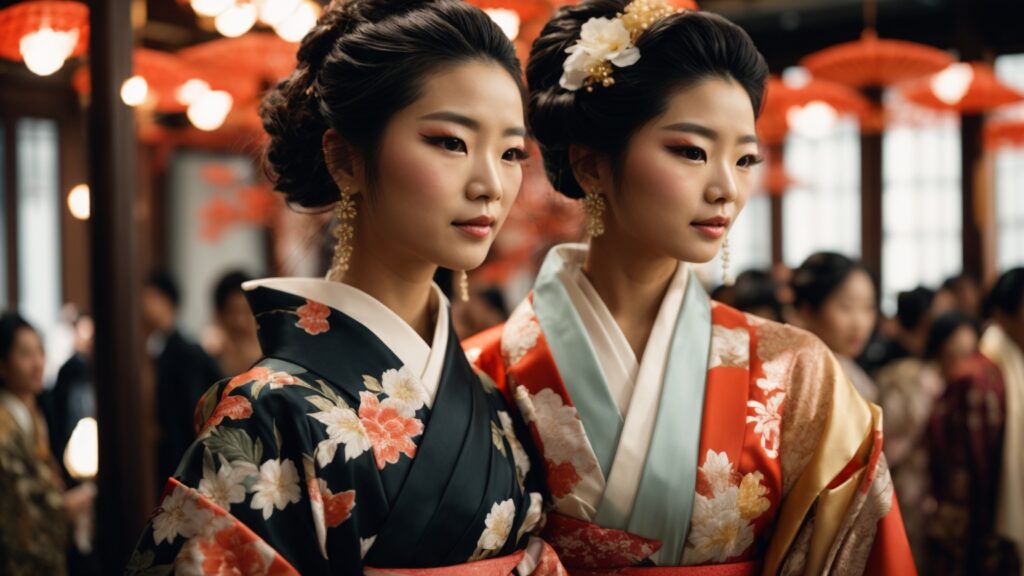
How to Wear a Kimonos in style 2023
As we enter 2023, the kimono is a versatile and stylish garment. This section offers practical tips for integrating kimonos into modern wardrobes, showcasing their adaptability and timelessness.
With their elegant drapes and rich patterns, Kimonos can be styled in numerous contemporary ways. Whether you’re aiming for a casual or sophisticated look, kimonos offer a unique flair to any outfit.
Case Study: Many celebrities and fashion influencers have recently embraced the kimono, showcasing its versatility. These public figures often pair kimonos with modern attire, setting trends and inspiring new ways to wear this traditional garment.
Kimono Cardigans – A Modern Twist
Kimono cardigans represent a fusion of traditional kimono aesthetics with a more casual, everyday style. These cardigans, often lighter and more streamlined, are perfect for layering and add a touch of elegance to any casual outfit.
Pairing Kimonos with Jeans for a Casual Look
Pairing a kimono with jeans is a popular choice for a relaxed yet chic look. This combination balances the flowing elegance of the kimono with the rugged, everyday appeal of denim.
Styling Tips for Kimonos with Dresses
- Match with Solid Colors: Pair a patterned kimono with a solid-coloured dress to create a balanced and harmonious look.
- Belt It Up: Use a belt to cinch the waist over a kimono for a structured silhouette.
- Play with Lengths: Experiment with different lengths – a long kimono over a short dress can create an intriguing contrast.
- Accessorize Wisely: Minimal accessories can complement the kimono’s intricate design without overwhelming it.
In 2023, kimonos continue to offer endless styling possibilities, blending traditional elegance with contemporary fashion trends. Whether through modern twists like kimono cardigans or classic pairings with jeans and dresses, kimonos remain a versatile and stylish choice for various occasions.
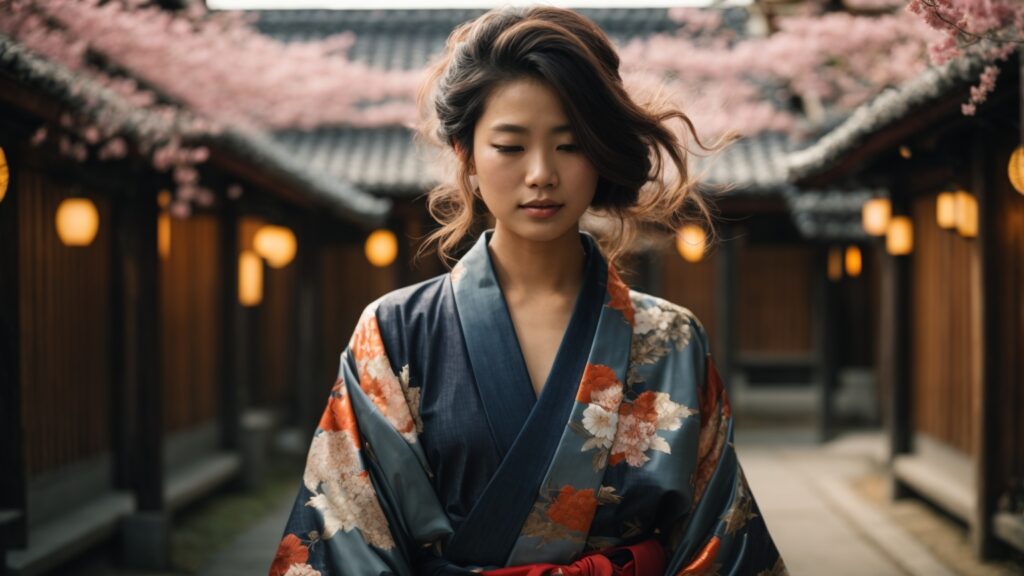
Kimonos and Modern Fashion Trends
Integrating kimonos into modern fashion trends is a fascinating development, reflecting a blend of tradition, sustainability, and innovation in today’s fashion landscape.
Kimonos have seamlessly weaved their way into contemporary fashion, symbolizing artistic expression and ethical fashion. Their unique design and cultural significance offer a fresh perspective on the modern fashion narrative.
Kimonos as a Symbol of Slow Fashion
Slow fashion, which emphasizes quality, sustainability, and ethical production, finds a perfect representation in kimonos. These garments, known for their durability and timeless style, encourage a more thoughtful approach to fashion consumption.
Kimonos in Sustainable Fashion Practices
In sustainable fashion, kimonos stand out for using natural materials and enduring design. This approach reduces waste and environmental impact, making kimonos an exemplar of eco-friendly fashion.
2023 Fashion Trends Featuring Kimonos
- Bohemian Chic: Kimonos with floral patterns and flowing fabrics are central to the Bohemian style trend.
- Street Style Edge: Edgier, shorter kimonos paired with streetwear items like sneakers and caps.
- Layering Pieces: Kimonos are used as dynamic layering over turtlenecks or shirts.
- Ethnic Fusion: Integrating traditional kimono patterns with Western fashion elements.
- Minimalist Elegance: Simplistic, monochrome kimonos in line with the minimalist trend.
Table: Comparison of Kimonos in Past and Present Trends
| Era | Style | Fabric | Use |
|---|---|---|---|
| Traditional | Classic, formal | Silk, hemp | Ceremonial wear |
| Contemporary | Diverse, casual | Various, including eco-friendly | Everyday fashion, statement pieces |
“Kimonos represent a shift towards conscious fashion choices, blending cultural heritage with a commitment to sustainability,” says a renowned sustainable fashion expert.
The role of kimonos in current fashion trends extends beyond aesthetic appeal; they symbolize the growing emphasis on sustainability and slow fashion. By embracing tradition and innovation, kimonos contribute significantly to shaping contemporary fashion narratives.
Cultural Significance of Kimonos Today
In today’s globalized world, the cultural significance of kimonos remains profound, symbolizing the enduring legacy and evolving narrative of Japanese culture.
With their rich history and symbolic meanings, Kimonos continue to play a crucial role in representing and preserving Japanese culture. Their use in contemporary society extends beyond fashion, embodying tradition, artistry, and cultural identity.
Ways Kimonos Represent Japanese Culture
- Symbol of Heritage: Kimonos are a living representation of Japanese heritage, showcasing centuries-old craftsmanship and art.
- Artistic Expression: The intricate designs and patterns of kimonos reflect traditional Japanese art and aesthetics.
- Ceremonial Importance: Kimonos are often worn during important ceremonies and festivals, maintaining their ceremonial significance.
- Cultural Ambassador: As kimonos gain international popularity, they serve as ambassadors of Japanese culture worldwide.
- Preservation of Craftsmanship: Making kimonos supports and preserves traditional textile arts and techniques.
Kimonos in Contemporary Japanese Ceremonies
Even today, kimonos are integral to many contemporary Japanese ceremonies, from tea ceremonies to weddings, where they symbolize respect for tradition and cultural continuity.
Different Types of Traditional and Modern Kimonos
| Type | Occasion | Characteristics | Modern Adaptations |
|---|---|---|---|
| Furisode | Coming of Age | Long sleeves, vibrant patterns | Adapted in modern fashion with shorter sleeves |
| Yukata | Summer Festivals | Light cotton, casual | Worn as summer attire globally, with diverse patterns |
| Uchikake | Weddings | Heavily embroidered, luxurious | Inspirations in bridal fashion across cultures |
| Homongi | Formal Events | Subtle, elegant designs | Incorporated in formal wear with a contemporary twist |
Kimonos today are much more than a fashion statement; they are a vibrant testament to Japan’s cultural depth and historical richness. As they adapt to modern sensibilities and global trends, kimonos continue to carry the essence of Japanese culture, making their cultural significance as relevant today as ever.
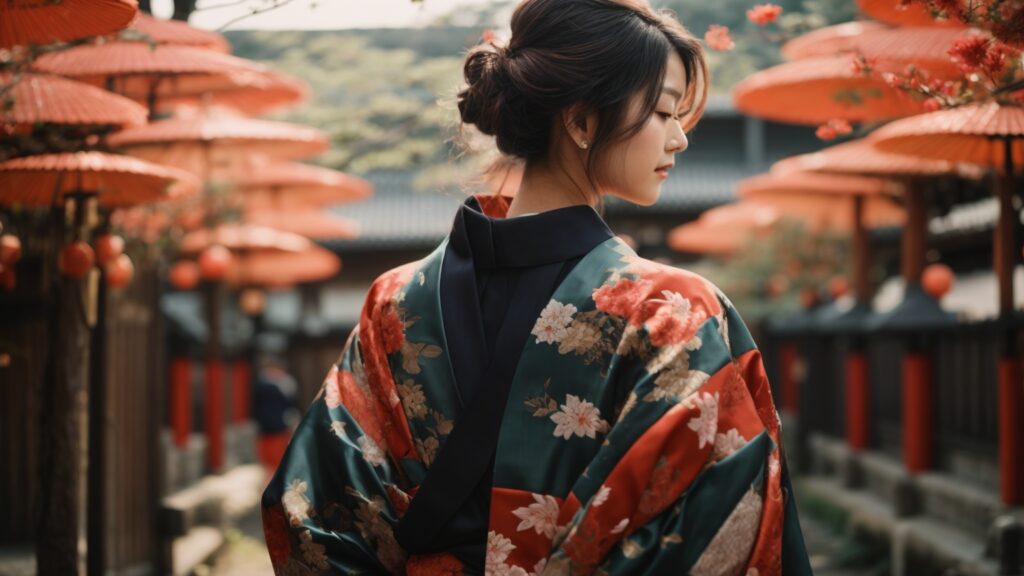
Kimonos in Mainstream Media and Influence
The traditional Japanese garment kimono has long transcended its cultural origins to become a staple in global fashion and media. This iconic attire has been portrayed in various forms in mainstream media, capturing the imagination of audiences worldwide. From classic films to modern TV shows, kimonos have been featured not just as a piece of clothing but as a symbol of elegance, mystery, and cultural depth. Their presence in media has played a pivotal role in shaping public perception and understanding of this traditional garment, elevating it beyond its origins to a global fashion icon.
Iconic Kimono Appearances in Film and TV
- “Memoirs of a Geisha” (2005): A cinematic representation of the intricate world of Geishas, showcasing the beauty and complexity of kimonos.
- “Kill Bill: Volume 1” (2003): Featuring a memorable fight scene where the protagonist dons a striking yellow kimono-inspired outfit.
- “In the Mood for Love” (2000): A film celebrated for its exquisite costume design, including beautiful kimonos that reflect the era’s fashion.
- “Blade Runner 2049” (2017): A futuristic take on kimonos, blending traditional designs with a dystopian aesthetic.
- “The Last Samurai” (2003): Depicts various styles of kimonos, highlighting their significance in Japanese culture.
The Influence of Kimonos on Global Fashion Designers
Kimonos have significantly influenced numerous global fashion designers, who draw inspiration from their unique style, fabric, and patterns. Designers like John Galliano and Alexander McQueen have incorporated kimono elements into their collections, merging traditional Japanese aesthetics with contemporary fashion. This blending of cultures and styles has led to innovative designs that celebrate the kimono’s heritage while pushing the boundaries of modern fashion. The influence of kimonos on global designers underscores their enduring appeal and versatility, making them a continual source of inspiration in the ever-evolving world of fashion.
Case Study: Consider the case of Stella McCartney, who integrated kimono-style jackets and prints into her Spring 2017 collection. Her approach was to combine the traditional kimono silhouette with Western tailoring techniques, creating both stylish pieces that respect the kimono’s cultural significance. This fusion exemplifies how contemporary designers can honor the essence of traditional garments while adapting them to modern fashion sensibilities.
The Impact of Kimonos in Shaping Global Fashion Narratives
With their rich history and stunning aesthetic, Kimonos have left an indelible mark on the global fashion landscape. Their portrayal in media has not only increased their visibility but also enhanced their cultural significance. The way kimonos have inspired fashion designers worldwide is a testament to their timeless beauty and versatility. As we continue to witness kimonos in various creative expressions, it’s clear that their influence extends far beyond their origins, shaping fashion narratives and trends across the globe.
Comparing Traditional and Contemporary Kimonos
The fashion world is constantly evolving, and the kimono is no exception. The traditional Japanese garment, known for its elegance and cultural significance, has undergone significant transformations to adapt to modern style preferences. While traditional kimonos are steeped in history and ritual, contemporary kimonos have emerged as versatile fashion pieces, blending heritage with new trends. Understanding the differences between traditional and modern kimonos reveals a change in design and a shift in cultural representation and use.
Key Differences in Design and Use
- Fabric and Pattern: Traditional kimonos often feature silk and intricate, handcrafted designs, whereas modern kimonos may use various materials, including cotton and synthetic fabrics, with simpler patterns.
- Structure and Fit: Classic kimonos are known for their T-shaped, straight-lined robes. In contrast, contemporary kimonos may have altered silhouettes, like looser or more fitted cuts, to suit current fashion trends.
- Wearing Occasions: While traditional kimonos are reserved for formal events and ceremonies in Japanese culture, modern kimonos are often worn casually and integrated into everyday outfits.
- Accessorizing: The traditional kimono is worn with an obi (a belt) and sometimes with additional layers like the haori. Modern kimonos are frequently styled with Western accessories like belts and scarves or even worn open without additional adornments.
The Craftsmanship Behind Traditional Kimonos
Traditional kimonos are a testament to the exquisite craftsmanship of Japanese artisans. Each kimono is a work of art, with careful attention paid to every detail, from the choice of fabric to the precision of the stitching. Creating a traditional kimono can take months, involving intricate techniques passed down through generations. This commitment to craftsmanship ensures that each traditional kimono is not just a garment but a piece of cultural heritage.
A renowned kimono artisan once said, “Creating a traditional kimono is like painting a story – each thread, color, and pattern represents a part of our history and the wearer’s personality. It’s not just clothing; it’s our culture.”
Innovations in Contemporary Kimono Design
Contemporary kimono designers have embraced innovation while honoring the garment’s origins. Modern kimonos often feature bold prints, varied lengths, and adaptations for different body types, making them more accessible and appealing to a global audience. Designers experiment with materials, colors, and patterns to create kimonos that align with current fashion trends, making them popular for various settings, from casual outings to formal events.
The journey from traditional to contemporary kimonos reflects the dynamic nature of fashion and cultural evolution. While traditional kimonos remain a symbol of Japanese heritage, modern kimonos have carved out their niche in the global fashion scene, offering a blend of tradition and modernity. Understanding this evolution helps us appreciate the kimono’s versatility and enduring appeal, making it a timeless piece in traditional and contemporary wardrobes.
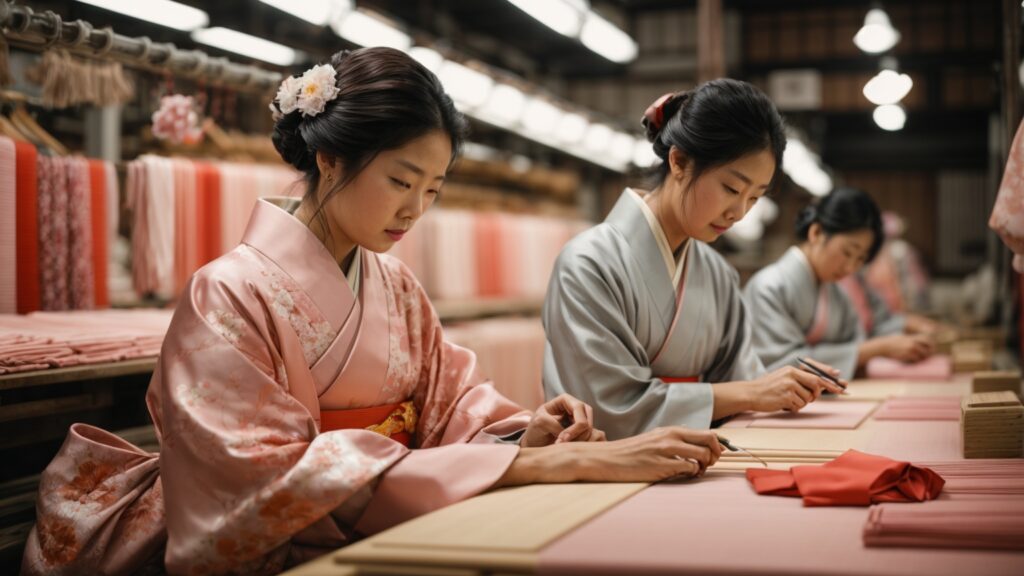
Future of Kimonos in Global Fashion
As we look towards the future, the kimono continues to hold a significant place in global fashion. Predictions and trends indicate that kimonos will maintain their classic appeal and adapt to new fashion sensibilities. Fusing traditional Japanese elements with contemporary design philosophies suggests an exciting evolution for kimonos. This evolution reflects a broader trend in fashion where cultural heritage meets modern innovation, creating garments that are both timeless and trendy.
Case Study: Consider the work of emerging designer Yumi Katsura, who has revolutionized the kimono scene with her modern interpretations. Her designs incorporate traditional kimono elements while infusing them with modern fabrics and patterns, making them more accessible to a younger, global audience. Katsura’s work exemplifies how new designers are reimagining kimonos, ensuring their relevance in the future of fashion.
The Role of Technology in Kimono Manufacturing
Technology integration in kimono manufacturing is set to redefine how these traditional garments are produced. Advanced textile printing, 3D modeling, and sustainable fabric sourcing are among the innovations shaping the future of kimono design. These technologies enhance production efficiency and open up new possibilities for customization and personalization, making kimonos more appealing to a generation that values uniqueness in fashion.
The Global Appeal of Kimonos in Diverse Cultures
Kimonos have transcended their Japanese origins to become a global fashion phenomenon. Their appeal lies in their versatility, elegance, and ability to blend seamlessly into various cultural contexts. As more people worldwide embrace multicultural fashion, kimonos will likely be adopted and adapted in diverse ways, reflecting a global appreciation for their beauty and heritage.
Forecast of Kimono Trends in the Next Decade
| Year Range | Trend Forecast |
|---|---|
| 2024-2025 | Rise in eco-friendly kimonos made from sustainable materials. |
| 2026-2027 | Increased use of digital customization tools in kimono design. |
| 2028-2029 | The emergence of kimonos in mainstream Western fashion as everyday wear. |
| 2030 | Fusion of kimonos with other cultural dress elements, creating hybrid styles. |
The future of kimonos in global fashion looks vibrant and promising. With emerging designers bringing fresh perspectives, the integration of technology in manufacturing, and the garment’s growing global appeal, kimonos are poised to remain a significant part of the fashion landscape. They will continue evolving, blending tradition with innovation, and maintaining their unique place in fashion. With its rich history and adaptability, the kimono is more than just a garment; it’s a symbol of the ever-evolving nature of fashion itself.
- Cute and adorable over a dress or tunic type blouse with skinny jeans!
- Perfect for matching with dress
- A great cover up for a bathing suit
- Loose design for more people of different sizes.
Conclusion
In 2023, the question are kimonos in style still garners a resounding yes. This year has seen a notable trend in versatile kimono styles, from flowy and lightweight versions perfect for hot summer days to elegant black kimonos that make a fashion statement. Recent posts in fashion blogs have highlighted various tips on how to style a kimono, such as wearing it atop a simple t-shirt for a casual look or pairing it with a v-neck dress for more formal occasions. Kimonos have proven that they are not just fashionable but also a way to add a layer of sophistication and cultural appreciation to any outfit, worn by both men and women.
The adaptability of kimonos during different weather months continues to enhance their appeal. They can also be worn with a turtleneck during cooler days or as a stylish cover-up over a swimsuit on summer days. Adding accessories like statement jewelry and a chic handbag can elevate the kimono this year, making it a timeless and stylish choice that resonates with current trends. That’s why it’s clear that kimonos are here to stay, blending tradition with modern fashion needs seamlessly.

James Dunnington leads the James Dunnington Collection, featuring five unique blogs: a practical Pet Care Guide, an enlightening Ancient History Blog, a resourceful Home Improvement Guide, a cutting-edge Tech Innovation Guide, and a strategic Online Money Making platform. Each site delivers valuable insights designed to empower and inform. For updates and more tips, visit our Contact Us page to sign up for our newsletter, ensuring you never miss out on the latest content from any of these dynamic fields.

